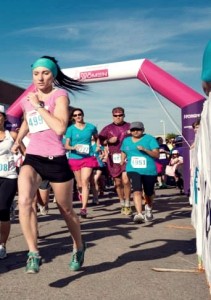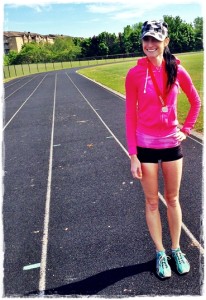On Sunday, June 1st, 2014, I ran the Run for Women 10km. Up until that day, I recently switched from running late in the afternoons to running in the mornings. Why? I read a paper that suggested you should train during the same time of day as your race and in most cases, 98% of all road races are held very early in the morning.
For the last 2 years as a forefoot runner, I ran before supper which is why racing in the mornings felt challenging. I felt unprepared and decided to run in the morning instead.
 I was ready for my 10km race and my race strategy was to focus my attention only on maintaining a wider step-width, nothing else.
I was ready for my 10km race and my race strategy was to focus my attention only on maintaining a wider step-width, nothing else.
In earlier races, I focused on too many aspects of my form, which left me overwhelmed and frustrated. Funny, I had learned in golf to focus on one ‘swing-thought’, or swing mechanic as too many swing-thoughts at once will cause you to lose your flow.
I now apply the same logic to running. Focusing on one aspect of my mechanics frees-up my mind and body allowing me to relax more.
 During the race, I held the lead for around 6km, which was a first for me. I was so excited to be ‘first’ for a large portion of the race. And, only 2 people (men) were ahead of me. My ‘one-thought’ focus strategy worked.
During the race, I held the lead for around 6km, which was a first for me. I was so excited to be ‘first’ for a large portion of the race. And, only 2 people (men) were ahead of me. My ‘one-thought’ focus strategy worked.
I am happy with my forefoot running performance and I felt great despite placing second female overall. However, achieving second female overall is another first for me. I also shaved one minute off of my personal best.
Another point to mention is that I found gazing at the ground, instead of continuously staring straight ahead while running helped me run smoother and took my mind off of the race, helping me zone out. I noticed a marked improvement in my forefoot running performance.
Please note, gazing at the ground does not mean I am running with my head down.
Running with a dropped eye-gaze actually enhances foot-placement awareness -you see where you are stepping and humans tend to gaze at the ground when running through forested trails as a reflexive action. Makes sense.
Why do I now run with a dropped eye-gaze?
I got that technique ‘tip’ from watching Tirunesh Dibaba, and other famous Ethiopian runners. They all run with their eye-gaze scanning the ground. Of course, they look up periodically, but they rarely stare straight ahead like most joggers.
If you let your eye-gaze fall to the ground, your head will naturally tilt down very slightly, you will find that you will run faster, with more finesse, on your forefoot.
Stay tuned!
More From Run Forefoot:
- Alberto Salazar Says Run Like a Sprinter to be a Great Distance Runner
- Running with Shin Splints Helps Improve Forefoot Running Technique
- Toe Running Causes Lower Leg Injury, Forefoot Running Does Not
- Contrary to Popular Belief, Switching From Heel Striking to Forefoot Striking Wont Increase Achilles Injury
- Running shoes for Forefoot Running
Run forefoot, because you are faster than you think!
Bretta Riches
BSc Neurobiology; MSc Biomechanics candidate, ultra minimalist runner & founder of RunForefoot. I was a heel striker, always injured. I was inspired by the great Tirunesh Dibaba to try forefoot running. Now, I'm injury free. This is why I launched Run Forefoot, to advocate the health & performance benefits of forefoot running and to raise awareness on the dangers of heel striking, because the world needs to know.
Latest posts by Bretta Riches (see all)
- Does Foot Strike Really Matter in Running? YES! - 17/04/2024
- Heel Lifts Increase Injury in Runners - 16/04/2024
- Are Minimalist Shoes Good for Seniors? YES! - 14/04/2024

Leave a Reply